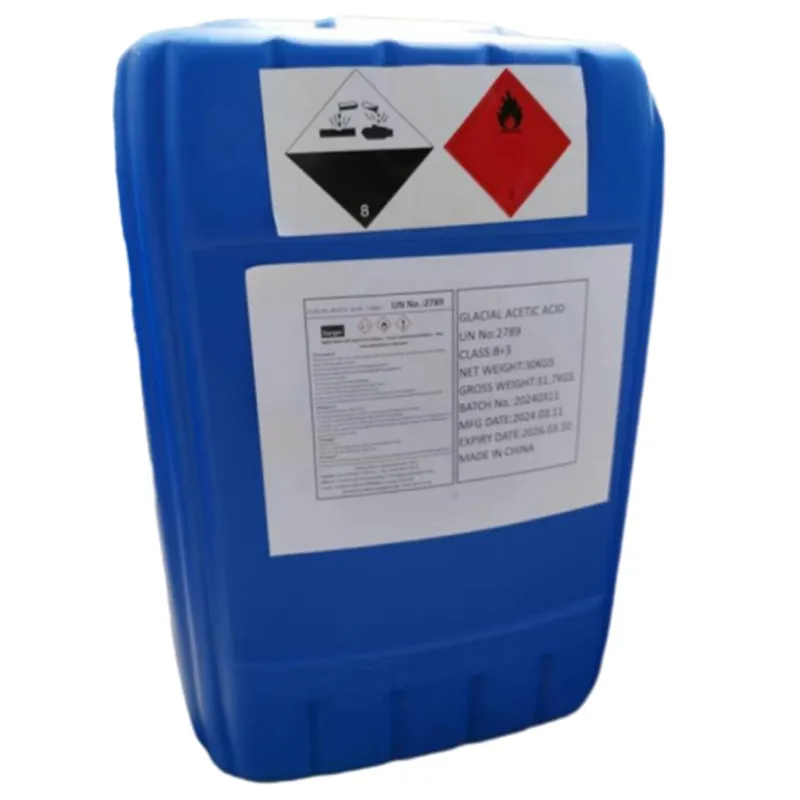
glacial aceticacid
Understanding Glacial Acetic Acid Properties, Uses, and Safety
Glacial acetic acid, a colorless liquid with a distinctive sour smell, is a fundamental chemical compound that plays an essential role in various industrial and laboratory applications. At its core, glacial acetic acid is the pure form of acetic acid, containing no water, and is typically regarded as a significant organic solvent and chemical reagent. This article delves into the properties, uses, and safety considerations associated with glacial acetic acid.
Properties of Glacial Acetic Acid
Glacial acetic acid is characterized by its molecular formula, CH₃COOH, and a molecular weight of approximately 60.05 g/mol. It has a freezing point of 16.6 °C (62 °F), which is why it is referred to as glacial. This term reflects its crystalline appearance when cooled below this temperature. The liquid has a boiling point of about 117 °C (243 °F) and is hygroscopic, meaning it can absorb moisture from the air. Its high acidity, with a pKa of around 4.76, allows it to participate in various chemical reactions, making it a vital component in organic synthesis.
Uses of Glacial Acetic Acid
Glacial acetic acid's versatility makes it invaluable in many industries. One of its primary uses is in the production of vinegar, where it is often diluted to create the common household condiment. In the industrial sector, glacial acetic acid serves as a precursor for the synthesis of numerous chemicals. It is instrumental in the manufacture of acetate esters, which are key ingredients in the production of plastics, textiles, and solvents.
Furthermore, it acts as a solvent for chemical reactions and is used in the synthesis of various pharmaceuticals, where it helps in the formation of active ingredients. Additionally, glacial acetic acid is crucial in the textile industry for dyeing and finishing processes. In the food industry, it’s used as a preservative and as a flavoring agent due to its antibacterial properties.
glacial aceticacid

In laboratories, glacial acetic acid is often employed as a reagent in organic chemistry experiments. It is utilized in the synthesis of acetyl derivatives and in various titration methods where its strong acidic nature is advantageous.
Safety Considerations
Despite its many benefits, handling glacial acetic acid requires caution. It is a corrosive substance that can cause severe burns upon contact with skin or eyes. Proper personal protective equipment (PPE), including gloves, goggles, and lab coats, should always be worn when working with this chemical. Inhalation of its vapors can irritate the respiratory tract, causing symptoms such as coughing and throat irritation. Therefore, glacial acetic acid should be used in well-ventilated areas or with appropriate fume hoods.
In case of accidental spills or exposure, it is crucial to follow safety protocols. Immediate rinsing of the affected area with copious amounts of water is advised, and seeking medical attention is important if any burning or irritation persists.
Conclusion
Glacial acetic acid is an essential compound in chemistry with diverse applications across various industries, from food production to pharmaceuticals and textiles. Its unique properties make it a powerful tool for chemical synthesis and industrial processes, while its corrosive nature necessitates conscientious handling and robust safety measures. As industries continue to evolve, the relevance of glacial acetic acid is likely to remain significant, underscoring the need for awareness and education regarding its proper use and potential hazards.
-
Pure Sodium Dichloroisocyanurate Dihydrate | Powerful DisinfectantNewsAug.29,2025
-
Industrial Chemicals: Quality & Purity for Every IndustryNewsAug.28,2025
-
Nitrile Rubber Honoring Strict Production StandardsNewsAug.22,2025
-
Aspartame Ingredients Honoring Food Safety ValuesNewsAug.22,2025
-
Fertilizer for Balanced Plant NutritionNewsAug.22,2025
-
Cyanide Gold Processing with High Purity AdditivesNewsAug.22,2025
-
Formic Acid in Textile Dyeing ApplicationsNewsAug.22,2025
Hebei Tenger Chemical Technology Co., Ltd. focuses on the chemical industry and is committed to the export service of chemical raw materials.
-

view more DiethanolisopropanolamineIn the ever-growing field of chemical solutions, diethanolisopropanolamine (DEIPA) stands out as a versatile and important compound. Due to its unique chemical structure and properties, DEIPA is of interest to various industries including construction, personal care, and agriculture. -

view more TriisopropanolamineTriisopropanolamine (TIPA) alkanol amine substance, is a kind of alcohol amine compound with amino and alcohol hydroxyl, and because of its molecules contains both amino and hydroxyl. -

view more Tetramethyl Thiuram DisulfideTetramethyl thiuram disulfide, also known as TMTD, is a white to light-yellow powder with a distinct sulfur-like odor. It is soluble in organic solvents such as benzene, acetone, and ethyl acetate, making it highly versatile for use in different formulations. TMTD is known for its excellent vulcanization acceleration properties, which makes it a key ingredient in the production of rubber products. Additionally, it acts as an effective fungicide and bactericide, making it valuable in agricultural applications. Its high purity and stability ensure consistent performance, making it a preferred choice for manufacturers across various industries.





